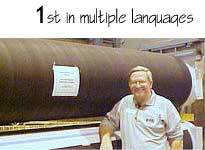Jim Thompson (jthompson@taii.com)
Week of 29 Sept 08 Now comes news from Karelia that mills are going out of business. Karelia is a pleasant, bifurcated area in eastern Finland. I say bifurcated because Stalin made sure that after World War II a portion of it remained within the borders of Russia. This now dimly in the past decision, dim for at least those of us not living there, is a source of a portion of the problem: Russia's new duty on the export of raw, unprocessed wood means these mills in modern-day eastern Finland have a new, burdensome tax on much of their raw material supply coming from Finland's own former lands.
Click here, then click "Trans lator" in top navigation bar for other languages.
Another source of the problem is this: despite extraordinarily keen attention to the stewardship of their industrial forests, the economics of tropical eucalyptus pulp have also caught up with these far-off mills. When one could carefully husband nearby resources, even if they were slow growing, one could make paper on modern machines and ship it to distant markets at an acceptable profit. But when economical fiber can be cheaply transported directly to state-of-the-art mills near finished goods markets, it makes little sense to haul it from one place to a neo-antipode and then on to a third market thousands of miles away.
For decades we have watched the march of the wrecking ball south from the forests of Canada to those of the northern tier of the United States. Poor forestry practices in some places, poor grade (market) choices in others, and a lack of reinvestment were and are often blamed for the plight of the old mills in the path of the cutting torch. Due to the remote location of these North American mill towns, we have seen governments at all levels, and some private investors that did not know any better, foolishly try scheme after scheme to save mill towns that have no choice but to die. The scene has become boringly predictable: within six months to a year of a new investment scheme reopening one of these dinosaurs, government officials and the local press say something like, "See, we told you we could save it (the mill)." Then, within a couple more years, the facility is closed once more, with blame being placed on some far-off fault, when the real fault was the repeated attempts to save a patient that needed more organ transplants than a skeleton at Halloween.
What is now interesting to a gadfly like me is to watch events develop in Finland. How will the Finnish people, a rugged lot if ever there was one, react to these adverse conditions visiting their shores? One matter that is different from North America: the forest products industry is a very significant portion of the Finnish economy; the shutdowns discussed in Karelia were cited by some sources as representing 1 to 1 1/2% of the Finnish GDP. Another: at least in pre-European Union days, Finland did not fear government ownership and participation in industrial businesses.
Finland has been an economic leader in the past. The last couple of decades have seen Finland turn to technology (it is so obvious I almost need not say it: Nokia) as a way for the country to earn an acceptable return on its most important resource, its people. At the same time, Finland has remained a powerhouse of modern forest products' practices, both in the industry it has maintained at home and in the technology, exported in various ways, it has shipped abroad. Yet, if what we are seeing now is the beginning of the end of the home-grown pulp and paper industry in Finland, what next? What next for Finland? And who or where dons the mantle of leadership in the forest products industry? For the problem, on a worldwide basis, is not lack of demand for pulp and paper products, but a changing economic paradigm and market shift that dictates the center of the pulp and paper industry move.
My unfolding fifteen year old prediction that the pulp and paper industry of 2045 consists of tissue, packaging and energy businesses indicates the center will not be in far northern climes. However, it is becoming increasingly clear to me where it will be, and, surprise, surprise it will not be China. I think it will be Africa. The only thing Africa lacks at the moment is pan-African political stability, yet in my lifetime, this continent has been moving ever so slowly towards such a condition. Democracy and civility have been nibbling at the edges of this vast land mass for decades. If, as a whole, the continent can achieve a modicum of stability, it can become the feeder for pulp and paper markets world wide. Much of the continent has the climate. Much of the indigenous rainforests have been depleted due to the subsistence lifestyle of the people and hence begs for rejuvenation, even with industrial eucalyptus. It is blessed with a location in the world's oceans which makes every other place close. When taken as a whole, the continent of Africa faces no major choke points (such as the Panama or Suez Canals) to reach any major pulp and paper consuming nation in the world. It is accessible in all seasons around its entire periphery. The soils are in poor condition in many places, but they can be improved. Africa is the least seismically active continent on earth (its only seismic history is along its northern coast). There are more reasons than not to bet on Africa as the future center of the pulp and paper industry. This is an opportunity for politicians, environmentalists and an industry, ours, to come together to fix a sad corner of the world.
Once direct service is warranted, it is only a nine hour flight from Helsinki to central Africa, with merely a one hour change in time zones. Time for some more Finnish exports?
Of course, with a "clean slate" start as I describe above, one can start with a fresh, higher standard towards safety. What can you do to improve your safety standards where you are today?
Be safe and we will talk next week.
